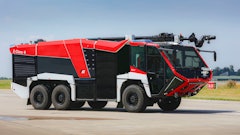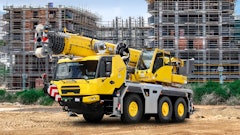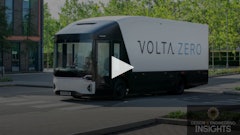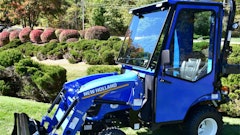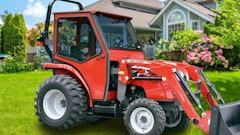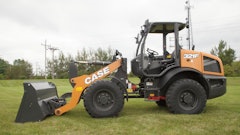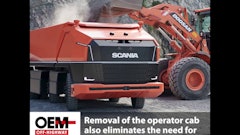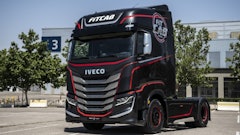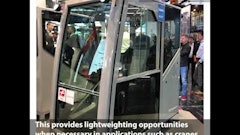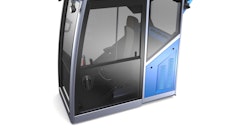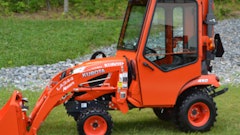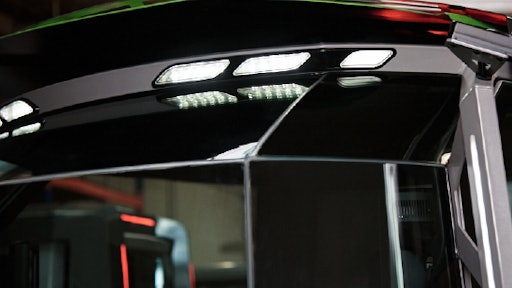
The curtain rose on a unique vehicle cab: the CAB Concept Cluster presented its Genius CAB to the international audience for the first time at bauma 2016. On April 10 in Munich, this model cab was awarded the bauma Innovation Award 2016 in the design category.
By exploiting existing synergies, the cluster partners were able to develop and implement the Genius CAB as a customer-neutral innovation platform in the space of only 18 months. The CAB Concept Cluster is a network of global players, innovation-driven OEM suppliers, renowned academic institutions, designers, industry associations and equipment renters and operators. Its members include the companies AURORA, Bosch, Fritzmeier Systems, GRAMMER, HELLA, HYDAC, MEKRA Lang, SAVVY Telematic Systems, S.M.A. Metalltechnik, the design agency Lumod, the Technical University (TU) of Dresden, VDBUM (an association of construction, environmental and mechanical engineering e.V.) and Max Bögl.
“The future trend in off-highway vehicles is for maximal efficient system integration accompanied by an increasing digitalization of equipment and cabs. We are all intensely concerned with our customers’ needs, with how the market of tomorrow will look and with how we can begin developing and implementing that today,” says Fritz Schadeck, Vice President of Fritzmeier Cabs. “The Genius CAB is our response to the challenges of the industry.”
Its integrated components in the areas of safety, intuitive operation, driver comfort, maintenance and design have set new standards for the international markets. Each individual component used is precisely tailored to the added value of the others, fulfilling specific user needs with near-series technology.
“For OEMs in the off-highway industry this means being able to rapidly finalize series production of all the innovations shown here with reduced costs, manageable risks while simultaneously enhancing their market competitiveness,” explains Dr. Thomas Hiebaum, Corporate Vice President Global Off-Highway, HELLA, who, together with Schadeck, promotes the network’s activities on the industrial side.
“All our conversations with customers in the construction machinery, agricultural machinery and industrial fork-lift and floor vehicle industries confirm that there is a great deal of interest in this tangible vision of a future-oriented wheel loader cab,” continues Dr. Hiebaum. “Joint global marketing has already begun.”
Unmistakable and unique overall picture
Never before have such high levels of technical innovation been incorporated into one cab. But the Genius CAB is far more than merely a vehicle for advanced technology: here, for the first time, all the manufacturers involved designed and developed the exterior and interior within a consistent styling concept.
The prizewinning overall design was the work of Prof. Dr.-Ing. Jens Krzywinski of the TU Dresden and Wanja S. Steinmaier from the design agency LUMOD. Its motto is ‘Human Centered Design’ and accordingly its high-quality and spacious interior is geared to providing an optimally ergonomic workplace. It takes into account the current trend for ‘cocooning’, which contributes to the protection and well-being of the human operator.
The exterior is designed to resemble a cut diamond: a robust setting with additively modular EXO-ROPS/FOPS supports and plastic cladding elements surrounds the cab’s glass cockpit with its faceted windows. These provide plenty of visibility and – being aligned at specific angles – reduce unwanted distortion.
The off-highway sector’s demands for styling and brand recognition in international markets are ever increasing. Shaping light lines that can be adapted to suit individual customers’ requirements further underline the brand-building character of the Genius CAB.
The most significant innovations contributed by Fritzmeier Systems were developing an integrative structure solution in the modular construction of a ‘SoftCab’ made of welded special aluminum profiles, which led to a weight reduction of 30%, and the form-compliant EXO-ROPS steel elements that are mounted additively on the cab and can be configured for weight classes from 10-50 t. The cab is also distinguished by a high level of weather resistance.
“All the interior cladding that is integrated into the cab structure and the window elements leads to significant cost advantages in series production for the OEMs,” says Schadeck.
Other features from Fritzmeier Systems are the cab’s newly developed details such as the ergonomic door handle and the electrically movable sunshade.
Emphasis on system integration
“What is so special about the Genius CAB! - It is the bringing together of the individual component innovations and the functional links of a large supplier network,” says Dr. Johannes-Jörg Rüger, EVP of Bosch Commercial Vehicles & Off-Road. “The development team’s task was to continually conduct LIVE and WEB meetings together with all partners, then to coordinate their ideas and in this way generate optimal interfaces.”
This model cab has been an unprecedented success. System integration plays a top role in the design of the exterior of the CAB. For example, the protection rails positioned in the blind spot of the A-posts are not only part of the rollover protection cage, they also serve as handrails, cable conduits and – with their LED lights – as signature elements. The aluminum front beam takes over the function as heat sinks for the integrated Matrix Beam worklights from HELLA.
These are able to refrain from illuminating specific areas in order to avoid dazzling drivers. For example, while the bucket of a wheel loader is raised, it is not illuminated and the light is routed past it.
Ultrasonic sensors from Bosch are integrated into the exterior to provide additional visualization of the surroundings. They detect dangerous situations by displaying relative positions and nearby obstacles, thus significantly increasing the standard of safety. The information is communicated to the driver via the display terminal and a HELLA ScenarioLight installed in the roof.
Instead of mirrors there is a camera system combined with a variable view reversing camera from MEKRA Lang – used here for the first time in a cab for an off-highway vehicle – which provides significantly better surround visibility, especially in the dark. It can also be used to display hard-to-see areas at the rear of the vehicle on the mirror-replacement screens inside the cab. At the same time the new ‘mirror image’ display entirely compensates for the vehicle’s vibrations.
“That is part of our implemented ‘one-stop-shop’ philosophy in which customers themselves determine the entire content,” explains Dr. Werner Lang, owner of MEKRA Lang.
Lots of High tech inside the cab
The ergonomic features of the driver’s workplace include clear information management, the latest human-machine interfaces (HMI) and the physical layout. With the assistance of RAMSIS, which is a 3D-model of a human in the form of ergonomic analysis software for CAD designs, those responsible have created optimal conditions for the driver as regards ingress, visibility, easy access to all the functions and the seating position. The special seat from GRAMMER offers wide range of settings including a massage function.
Also integrated into the GRAMMER seat armrest is a force-feedback joystick combined with physical buttons and a highly professional 12-in. touchscreen panel.
This means that all the functions and machine characteristics that the driver can control are centrally visible and can be modified at any time, even under adverse working and lighting conditions. One such device is an electronically controlled windshield wiper from Bosch. An adaptive user interface summarizes the key parameters and ensures safe, targeted navigation through the menu structure.
CAN Network
A new feature of the Genius CAB is the CAN network that links together all the functions and components. The central body computer from Bosch operates on a complex modular CAN matrix as the control center for numerous other CAN-enabled components and functions, and processes all the incoming and outgoing signals. Smart cloud technology from SAVVY Telematic Systems uses RFID tags to record the working and operating times of the operator and the equipment, register the equipment status and log possible damage. For example, the scene-based lighting control satisfies customers’ increasing demand for convenience and comfort, and the active access control system from HELLA and SAVVY Telematic Systems fulfills the demand for increased safety and security in all areas. By means of appropriate key codes it is possible to flexibly broaden or restrict the range of functions available to the operator.
Super environment and optimized maintenance
The air-conditioner from AURORA can be conveniently controlled by the machine operator via the central touchscreen panel. The set of new-style air vents have been optimally arranged for individual, tailored ventilation together with the heater and air-conditioner.
The quality of maintenance inside the cab is significantly enhanced by the use of RFID-chipped air filters from HYDAC. The service life and usage state of the filters are continuously monitored. There is no longer any need to replace filters ‘just in case.’ The cab interior takes into account the space required for air ducts, and particularly the need for easy access to the filter system. This is especially important for the particular requirements of the construction and agriculture industries.
“Thanks to the consolidated expertise from scientists and practitioners, their team spirit and the continuous exchange of knowledge and experience in our network, the Genius CAB has enabled us to demonstrate to the OEMs of the off-highway industry the enormous potential of effective system integration. We continually pushed the envelope of the integration concept and have created a unique project that carries considerable weight in the international markets,” concludes Georg Fritzmeier, owner of the Fritzmeier group.






